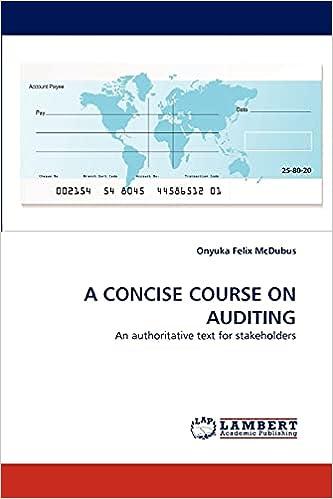Question
Planet Light First (PLF), a producer of energy-efficient light bulbs, expects that demand will increase markedly over the next decade. Due to the high fixed
Planet Light First (PLF), a producer of energy-efficient light bulbs, expects that demand will increase markedly over the next decade. Due to the high fixed costs involved in the business, PLF has decided to evaluate its financial performance using absorption costing income. The production-volume variance is written off to cost of goods sold. The variable cost of production is $2.40 per bulb. Fixed manufacturing costs are $1,170,000 per year. Variable and fixed selling and administrative expenses are $0.20 per bulb sold and $220,000, respectively. Because its light bulbs are currently popular with environmentally conscious customers, PLF can sell the bulbs for $9.80 each. PLF is deciding among various concepts of capacity for calculating the cost of each unit produced.
Theoretical capacity 900,000 bulbs
Practical capacity 520,000 bulbs
Normal capacity 260,000 bulbs (avr expected output for next 3 years)
Master budget capacity 225,000 bulbs expected production this year
Capacity Type Capacity Fixed Mfg. Fixed Mfg. Variable Inventoriable
Level Overhead Overhead Rate Prod Cost Cost per Unit
Theoretical 900,000 $1,170,000 $1.30 $2.40 $3.70
Practical 520,000 $1,170,000 $2.25 $2.40 $4.65
Normal 260,000 $1,170,000 $4.50 $2.40 $6.90
Master Budget 225,000 $1,170,000 $5.20 $2.40 $7.60
Capacity Type Capacity Fixed Mfg. Fixed Mfg. Fixed Mfg. Volume Variance
Level Overhead Overhead Rate Overhead Rate x
Actual Prodcution
Theoretical 900,000 $1,170,000 $1.30 $ 390,000 $780,000 U
Practical 520,000 $1,170,000 $2.25 $ 675,000 $495,000 U
Normal 260,000 $1,170,000 $4.50 $1,350,000 $180,000 F
Master Budget 225,000 $1,170,000 $5.20 $1,560,000 $390,000 F
Theoretical Practical Normal Master Budget
Revenue a $2,205,000 $2,205,000 $2,205,000 $2,205,000
Less: Cost of
goods sold b 832,500 1,046,250 1,552,500 1,710,000
Production-volume
variance 780,000 U 495,000 U (180,000) F (390,000) F
Gross margin 592,500 663,750 832,500 885,000
Variable selling c 45,000 45,000 45,000 45,000
Fixed selling 220,000 220,000 220,000 220,000
Operating income $ 327,500 $ 398,750 $ 567,500 $ 620,000
Required:
1. If PLF sells all 300,000 bulbs produced, what would be the effect on operating income of using each type of capacity as a basis for calculating manufacturing cost per unit?
2. Compare the results of operating income at different capacity levels when 225,000 bulbs are sold and when 300,000 bulbs are sold. What conclusion can you draw from the comparison?
3. Using the original data (that is, 300,000 units produced and 225,000 units sold) if PLF had used the proration approach to allocate the production-volume variance, what would operating income have been under each level of capacity? (Assume that there is no ending work in process.)
Step by Step Solution
There are 3 Steps involved in it
Step: 1

Get Instant Access to Expert-Tailored Solutions
See step-by-step solutions with expert insights and AI powered tools for academic success
Step: 2

Step: 3

Ace Your Homework with AI
Get the answers you need in no time with our AI-driven, step-by-step assistance
Get Started


